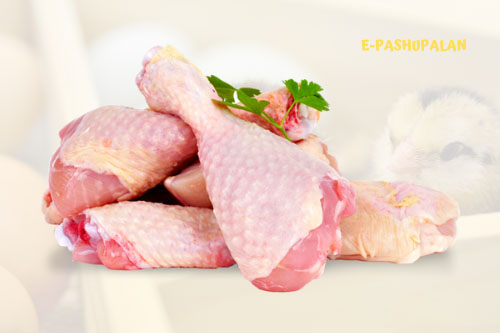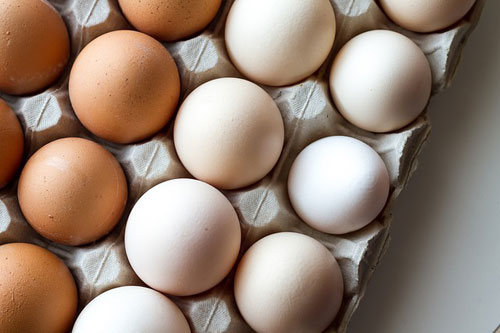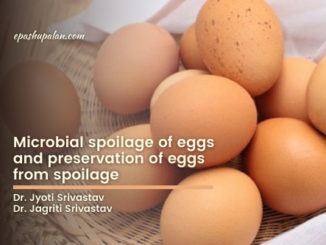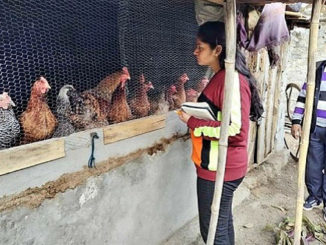Abstract
Poultry industry has shown significant growth in India as well as in the world by bringing paradigm shift in its structure and operation. Poultry industry has turned out to be self-sufficient, supported by a broad and strong genetic base. In the last 2-3 decades, both egg and meat industry has registered significant growth, Apart from that, technological interventions has been used to improve the economic traits like growth rate, livability, disease resistance, feed efficiency and egg and meat quality, etc. Significant impact of these modern technologies can be seen in the layer and broilers segments of poultry industry. Endocrinological (hormone-based) gender identification in the hatching egg is now possible. CRISPR gene editing and RNAi technology for altering the sex of the embryo as per the requirement are bringing revolutionary changes in the poultry industry. Nutrigenomics, in ovo injection of nutrients, augmentation of nutrient bioavailability and formulation of low cost, efficient and balanced feed for poultry using software has also come up. Technologies for bringing compositional changes in egg and meat have led to the emergence of the concept of designer eggs and designer meat. Manufacturing technologies for value addition have increased the variety, flavor and shelf life of poultry products. Easy traceability and accountability using blockchain, Internet of Things etc. are some other added advantages of incorporating technology in poultry industry.
Keywords: CRISPR, RNAi, Nutrigenomics, Augmented reality, Virtual reality, Blockchain, Internet of Things
Introduction
Poultry industry is one of the fastest growing industries in India and across the world. Being an important sub-sector of livestock, it plays an important role in country’s economy. Factors like growing population along with rise in per capita income and fall in real poultry prices are further expanding this industry. Significant growth has been registered in both egg and meat industry. The poultry sector has undergone a paradigm shift in structure and operation over the years with sizeable investments in selection, breeding, hatching, rearing and processing technologies. This has come into a reality due to the increasing support from government, increased research and development by research institutes, international collaboration and participation of the private sector.
Indian poultry is self-sufficient, supported by a broad and strong genetic base. India ranks third in egg production and fifth in meat production with total population of 851.81million (20th Livestock Census, 2019) which revealed an increase of 16.8% over the previous census i.e. 729.2 million (19th Livestock Census, 2012). The annual egg production is approximately 94.2 billion eggs with an average growth rate of 6% and the annual poultry meat production is 3.78 million
tons with a growth rate of 8-10% (BAHS, 2018). In India, the annual per capita availability of egg and meat is only 74 eggs and 2.8 kg (BAHS, 2018) respectively whereas in developed countries it is 240 and 20 Kg respectively which indicates a huge potential of further improvement of poultry production. Major objective is to genetically improve the efficiency of production, quality of eggs and meat and the health and welfare of poultry.
In the last 2-3 decades, many economic traits like egg production, growth rate, livability, disease resistance, feed efficiency and egg and meat quality, etc have been genetically improved by utilizing modern technological interventions along with the conventional breeding methodologies. Significant impact of modern technologies can be seen in the layer and broilers segments of poultry industry. The technologies used are such that they support higher rate and persistency of egg production, better feed efficiency, egg size, egg quality (internal as well as external) and livability in layers and enhances the growth rate, muscle mass, carcass quality, feed efficiency and livability in broilers. Value addition and easy traceability are some other added advantages of incorporating technology in poultry industry.

Technology in Egg sexing and sex altering domain
Incubation and hatching of eggs are two important practices in egg laying industry and sexing is usually done after completion of hatching. As a result of which the male eggs are incubated and allowed to hatch. It has been reported that around 300 million male chicks are killed as they cannot lay eggs thereby it is not economical to fatten them. Certain technologies have been developed to combat this.
SELEGGT GmbH is an automated, scientific approach of endocrinological (hormone-based) gender identification in the hatching egg. the eight to ten day incubated egg is checked if fertilized or unfertilized using sensor. A fine hole is then created in the egg shell using laser for extraction of a tiny droplet of allantois fluid (in female, the fluid contain estrone sulphate). This fluid is placed in a patented marker in which estrone sulphate show reaction and changes color, thereby differentiating the male and female eggs prior to hatching.
eggXYT CRISPR Gene Editing Technology: This technology involves the insertion of a bio-marker in the DNA of male chicks at the parent stock level, creating an optical signature in embryos. Thus male chicks can be easily detected during the breeding/ hatching operation. The incoming eggs are scanned and eggs with male embryos are diverted to food production (Thornton, 2018). The technology Developers are negotiating with major breeding companies to incorporate the technology in the stock.
RNAi technology: Altering the sex ratios in poultry is now possible using this technology (Kumar and Pandey, 2019b). It is capable of generating single sex populations i.e. generation of only female chickens in the layer poultry industry, and only males in the broiler industry can increase the productivity and profit multifold times. This manipulation is possible by modifying the activity of key sex-determining genes during embryonic stage. Development of testes in chicken embryo requires DMRT1, a Z-linked gene (Smith et al., 2009) and targeting this gene using retro virus delivered RNAi can induce the development of partial or complete ovaries thus producing genetic males (ZZ) with attributes of female. Similarly, female development requires aromatase expression in chickens (Lambeth et al., 2013). RNAi can be used to knockdown aromatase in the broiler industry, thereby, producing only male chickens.
Technology in nutritional domain
MAKEFEED POULTRY software: It is window based computer software developed by the scientists of ICAR- Centarl Avian Research Institute, Izatnagar, Bareilly. It uses the database of diversified agro-climatic conditions of India to formulate low cost, efficient balanced feed for layer and broiler chickens, quails, guinea fowls, turkeys etc.
Augmentation of nutrient bio-availability in non-conventional feedstuffs: Various technologies utilizing the physical, chemical and biological treatments are now available for augmenting nutrient bio-availability in non-conventional feed stuffs. These include washing with water, wet processing and reconstitution with or without enzymes, dry processing using acidified sodium chlorite treatment for feed hygiene, roasting, autoclaving, alkali and acid treatments, fungal treatment and fermentation of the feed ingredients. Phosphorus utilization can be significantly improved by adding microbial phytase in diets of broiler chicks, egg type chickens, guinea fowl and quails. Studies have shown that the nutritive value of droppings of quail improves by fermentation technique using Pleurotus sajarcaju. Mineral chelates, prebiotics, probiotics, feed sanitizers have also found to play important role in enhancing the immune response as well as production performance of poultry.
Technique of in ovo injection of nutrients: Standardization of in ovo feeding and in ovo vaccination in chicken and turkey has resulted in better post-hatch growth and immunity in the birds. Certain nutrients that can modulate the genes related to growth and immunity have been identified and used to develop a package for in ovo intervention resulting in better post-hatch growth and increased immunity against common diseases.
Nutrigenomics: It is one of the most interesting and explicable area providing techniques that can revolutionize the poultry industry by addressing both resource issues and changing expectations. One of the most finest example of nutrigenomics in practice is Ecomomas E (Thiruvenkadan and Prabakaran, 2017). It showed that its use can augment the same pattern of gene expression even if Vitamin E content in feed is reduced by as high as 80% thereby substantially reducing the cost of feed. Programmed Nutrition (PN) has made it possible to use nutrigenomics for delivering diets that can lower down the excretion of mineral, improve the antioxidant status of the birds, availing alternative feed materials, making the diet more cost effective and enhancing the quality of poultry egg and meat (Kumar and Pandey, 2019a).
Technology in poultry products domain
Technology for bringing Compositional changes: technological advancements has led to an increasing attempt to change the composition of egg either by nutritional or genetic manipulation to meet the changing requirements of human beings like altering the fatty acids and cholesterol level, and adding therapeutic pharmaceutical compounds etc. Designer meat and designer eggs are the newer concept coming up and becoming popular among the masses.
Designer meat having higher levels of antioxidants (selenium, carotenoid pigments, vitamin-E, flavonoid compounds, phosvitin and lecithin) and herbal active principles (Allicin, Betaine, Eugenol, Lumiflavin, Lutein, Sulforaphane, Taurine Eugenol, Lumichrome, Lycopene, Curcumin, Carnosine, Quercetin) is attracting the focus of researchers and technologists (Sireesha and Prasanna, 2019). The main advantages with designer meat are- rich source of antioxidants, less susceptibility to lipid peroxidation, prevention of fishy taint to the product, , minimizes the destruction of fat-soluble vitamins and natural fat-soluble pigments to a considerable level.

Designer eggs are rich in several vitamins like vitamin A and E. The micro mineral content (selenium, iodine, zinc, copper and chromium) in the yolk and albumen of such eggs can also be increased. Designer eggs are seen as a solution to the problems of iodine deficiency in India (Kaufmann et al., 1998). With the ever increasing problem of heart diseases in the human beings, scientists have successfully reduced the cholesterol content of eggs by using genetics, nutrition or pharmacological intervention (Kim et al., 2004; Elkin, 2007). Techniques and technologies are now available to produce genetically modified chickens which produce eggs having any of the desired compound e.g., insulin for diabetic patients’ treatment (Mahima et al.,2012). U.S. Food and Drug Administration have approved a transgenic chicken that can produce a drug named as Kanuma (sebelipase alfa) in its eggs. It is a recombinant human enzyme that helps in replacing a faulty enzyme which prevents the breakdown of fatty molecules in the cells of the people suffering from this rare, inherited condition (Becker, 2015).

Manufacturing technology for value-added poultry products: Advancements in technology has led to the coming up of various value added products in the market. Value addition increases the taste, price as well as the shelf life of the product. Some such value added meat products are: cured and smoked chicken, chicken patties, chicken nuggets, intermediate moisture chicken meat, chicken chunkalona, chicken meat spread, marinated chicken breast fillets, vinegar based chicken gizzard pickle, cooked chicken stock (One minute curried chicken), mixed chicken loaf, cooked chicken roll etc. similarly there are various value added egg products like pickled eggs, albumen rings, salted egg, egg strips, egg waffles, egg pancake, egg roll, egg crepe etc.
The manufacturing technologies have advanced to such an extent that now even the poultry slaughter by-products based pet food is available. Pet food biscuits can be prepared by using ingredients like poultry slaughter by-products (excluding feathers), damaged egg liquid, bakery waste, mixed cereal flour, soybean oil and permitted food additives which have a shelf-life of about 4 months at room temperature.
Miscellaneous technologies in poultry industry
Augmented reality is a technology that enriches the view of user by either overlaying information or showing things that humans cannot detect by bare eyes (bolidt.com). This technology can be used in the processing plant where a head mounted unit can show the trimmers where and how to prepare a bird through an overlay on the screen or laser scanner can give trimming instructions directly onto the product. Direct trimming instructions requires no special training and also no new equipment has to be installed so is an easier and cheaper option. Consumers can use augmented reality to receive more information about the source of food and the processes through which the food has undergone. Transparency is one of the most important and fast growing requirement of any industry where augmented reality can play an important role, hence must not be neglected even in poultry industry.
Virtual reality is the budding technology in which one can experience a completely new and controlled environment. It can help in keeping an eye on the birds and walking through the entire farm without disturbing them. It can also be used to provide a virtual tour to the consumers which build confidence among the consumers about the quality of the products and services that they are receiving. However it is an expensive technology. The concept has been taken a little too far by professor Austin Stewart, University of Iowa where they put virtual reality headsets on chicken which gives the feeling and enjoyment of free range life to the chickens that are actually raised in a close urban facility.
Blockchain is one among the most transformative technology for agriculture. It can bring complete transparency in food supply chain. It is a mirror of the origin, distribution and supply of food. In poultry industry, it can be used to fetch complete details about where the bird came from, how it was fed and raised and how it was processed. The creation of virtual invoice, accessible to all the parties in real time can make accounting more transparent. The technology is already in use in China and U.S. Soon it will form a massive part of the food industry’s future, driving quick changes (Alonzo, 2018)
The Internet of Things: IOT technology is the result of the growing web connectivity in everyday used devices and objects. It has a very rich potential for collecting data using some attached sensors. IOT can simplify the sharing and analysis of data. It allows one to have as much information as possible with easy accessibility (Alonzo, 2018).
Conclusion
The beauty of Science lies in its continuous up-gradation and bringing out newer technologies with time. So many features of poultry industry have already been revolutionized by these modern technologies. The transparency, product tracking, automation of industry and continuous improvement of birds’ flock and their products as per the changing requirements are shaping the newer face of this industry. However, the robotics, drone and use of sensors are still in their infancy and needs to be implemented keeping economics into consideration. In the last few decades the industry has evolved a lot and it is expected to further evolve at a much faster pace in the near future.
References
- Alonzo, A. (2018). 9 disruptive technologies coming to the poultry industry. WATTPoultry.com, retrieved on 24/2/2021. https://www.wattagnet.com/articles/33436-disruptive-technologies-coming-to-the-poultry-industry
- Becker, R. (2015). US government approves transgenic chicken. Nature: International weekly journal of science. https://www.nature.com/news/us-government-approves- transgenic-chicken-1.18985
- Bosselman, R.A., Hsu, R.Y., Briskin, M.J., Boggs, T., Hu, S., Nicolson, M., Souza, L.H., Schultz, J.A., Rishell, W. and Stewart, R.G. (1990). Transmission of exogenous genes into the chicken. J. Reprod. Fert. Suppl. 41:183-195
- Crittenden, L.B. (1991). Retroviral elements in the genome of the chicken: Implications for poultry genetics and breeding. Crit. Rev. Poultry Biol. 3:73-109
- Elkin, R.G., (2007). Reducing shell egg cholesterol content. II. Review of approaches utilizing non-nutritive dietary factors or pharmacological agents and an examination of emerging strategies. World’s Poult. Sci. J., 63: 5-31.
- Freeman, B.M. and Bumstead, N. (1987). Transgenic Poultry: theory and practice. World’s Poultry Science Journal 43:180-189
- https://www.bolidt.com/en/top-three-innovations-which-are-changing-the-poultry-industry, retrieved on 25/2/2021.
- Kaufmann, S., G. Wolfram, F. Delange and W.A. Rambeck, (1998). Iodine supplementation of laying hen feed: a supplementary measure to eliminate iodine deficiency in humans? Z Ernahrungswiss, 37: 288-293.
- Kim, J.H., S.T. Hong, H.S. Lee and H.J. Kimt, (2004). Oral administration of pravastatin reduces egg cholesterol but not plasma cholesterol in laying hens. Poultry Science, 83: 1539-1543.
- Kumar, S. and Pandey, M. (2019(a)). Advancements in Biotechnology for Safer Poultry Production in India, In Compendium of XXXVI Annual Conference of Indian Poultry Science Association and National Seminar on “Conceptual understanding and future strategies for welfare friendly poultry production in India” at CGKV, Durg, during Dec., 11-13, 2019, LP-5: 26-33.
- Kumar, S. and Pandey, M. (2019(b)). Futuristic technologies in Poultry Production, In Souvenir cum Compendium of 18th Annual Convocation cum Scientific Convention on “Futuristic Technologies in Animal Health and Production” of National Academy of Veterinary Sciences (India) at Kamdhenu University, Gandhinagar, Gujarat during Dec., 26-27, 2019, LP-08: XII.
- Mahima, Verma,A.K., Kumar, A., Kumar, V., Rahal, A. (2012). Designer Eggs: A Future Prospective.Asian Journal of Poultry Science, 6 (3): 97-100.
- Salter, D.W. and Crittenden, L. B. (1987). Chickens transgenic for a defective recombinant avian leukosis proviral insert express subgroup A envelope glycoprotein. Poultry Science, 66 (11):170.
- Salter, D. N. and Crittenden, L. B. (1988). Gene insertion into the avian germ line . Proc. Symp. Animal Breeding Opportunities, sponsored by the Br. Soc. Animal Prod. and the Br. Poultry Breeders Roundtable, Occas. Publ. Br. Soc. Anim. Prod.12: 32-57.
- Sireesha, P. and Prasanna, S. (2019). Designer eggs and poultry meat as functional foods – An overview. The Pharma Innovation Journal, 8(4): 829-831.
- Thiruvenkadan, A.K. and Prabakaran, R. 2017. Recent Approaches in Poultry Breeding. Approaches in Poultry, Dairy & Veterinary Sciences. DOI: 10.31031/APDV.2018.02. 000533
- Thornton, G. 2018. 16 innovations to change poultry production. WATTAgNet.com. https://www.wattagnet.com/articles/36187-innovations-to-change-poultry-production






1 Trackback / Pingback